
A vast network of underground chambers and water tunnels have been discovered beneath several of the world’s most well-known pyramids, including the Great Pyramid on Egypt’s Giza Plateau.
For centuries these ancient tunnels have remained hidden and off-limits to everyone but a select few. But now they are coming into the Light and what is being found raises even deeper questions.
There is an ancient Hermetic saying: “As Above, so Below,” meaning “That which is Below corresponds to that which is Above, and that which is Above corresponds to that which is Below, to accomplish the Miracle of the One Thing.”
This is especially true when it comes to the many mysteries surrounding all the world’s pyramids. In truth, we are just beginning to put together the puzzle pieces that have eluded us for centuries. Therefore, I was determined to know more about what was below ground.
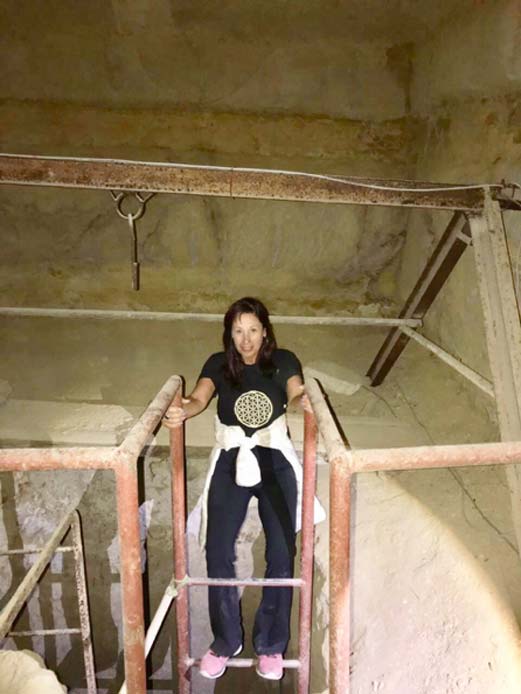
Author, Dr. Kathy Forti prepares to descend under the Giza Plateau. (Author provided)
Access to the Underworld
It wasn’t easy getting permission to explore under the Giza Plateau. Negotiations to enter the hidden shafts began in 2017. We were initially met with suspicion by Egyptian authorities who wanted to know who we were, what we wanted, and how we even knew about the shafts. They claimed no one had been down there in decades. Initially they refused our request, but eventually caved in for a price. In Egypt, all things are negotiable. (Our entry has now opened the way for others wanting access, but also for a hefty price.)
So it was in early 2018, at 4:30 AM, when a Giza Plateau inspector, my Egyptologist friend Hares and myself plodded across the desert sands with only a flashlight to light our way in the morning chill. A military police escort hovered nearby.
In the darkness, we were led to an iron-gated entry under the causeway between the pyramids. The inspector handed me the key and allowed me the honor of opening this secret doorway. In the past they referred to this hidden place as “that shaft complex”. They now officially call it the “Osiris Shaft”.
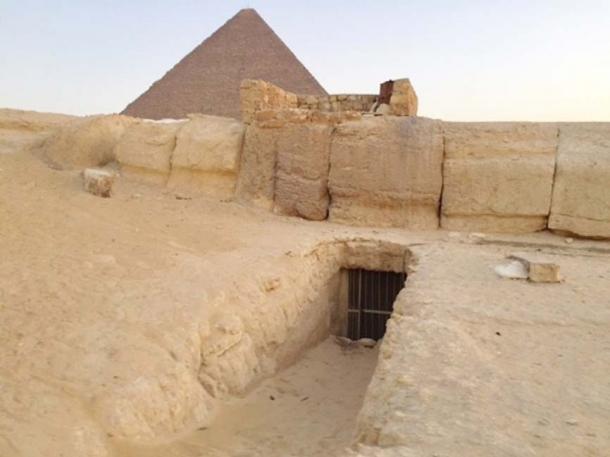
Entrance to the Osiris shaft. (Author provided)
A few steps inside the heavy gate there is a square hole in the ground. The inspector pointed to an iron ladder leading down this first shaft. From what I could see in the darkness, it didn’t look all that sturdy and I had no idea how old or maintained it was. This was one time when no male offered to go first. Instead, they let me lead the way with the caveat, “be careful.” (The liability factor in traversing such shafts would be off the charts in the U.S., but things are different in Egypt.)

First stage of descent into ‘that shaft complex’ below the Giza Plateau. (Author provided)
I was told there were three lower levels, the last leading to the water tunnels more than 125 feet (38 meters) below ground.
The first level opened to a spacious but empty room. The air felt close and dusty, the temperature much warmer with little outside ventilation. I continued my descent to the second level, the longest, where the lighting was low, lit by a single bulb hanging from the ceiling which someone had thought to put in place years ago.
Resting Chamber of the Favored Ones
I stepped down and turned to find a chamber room with seven niches for seven large sarcophagi. Only two black basalt and granite sarcophagi were still there, both empty with their heavy lids slightly ajar. They had to weigh several tons. I wondered how they had managed to remove the other five sarcophagi, if they indeed existed. I was told this chamber was for the “favored ones”—the guardians which tended to be the highest of priests.
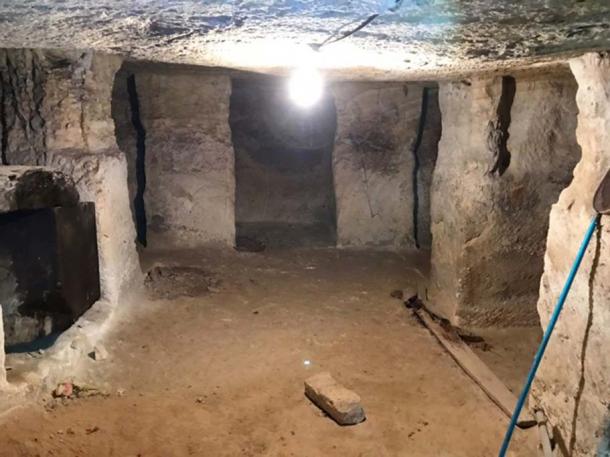
Chamber with niches for seven sarcophagi. (Author provided)
According to Herodotus, ancient Egyptian priests spoke of a long-held tradition of the creation of underground chambers by the original builders of ancient Memphis. These stories were confirmed when these large cavities were discovered during a survey conducted at Giza in 1993.
An article about the find stated: “…We have discovered a subway used by the ancient Egyptians of 5000 years ago. It passes beneath the causeway leading between the second Pyramid and the Sphinx. It provides a means of passing under the causeway from the Cheops Pyramid to the Pyramid of Chephren [Khephren]. From this subway, we have unearthed a series of shafts leading down more than 125 feet, with roomy courts and side chambers…”.
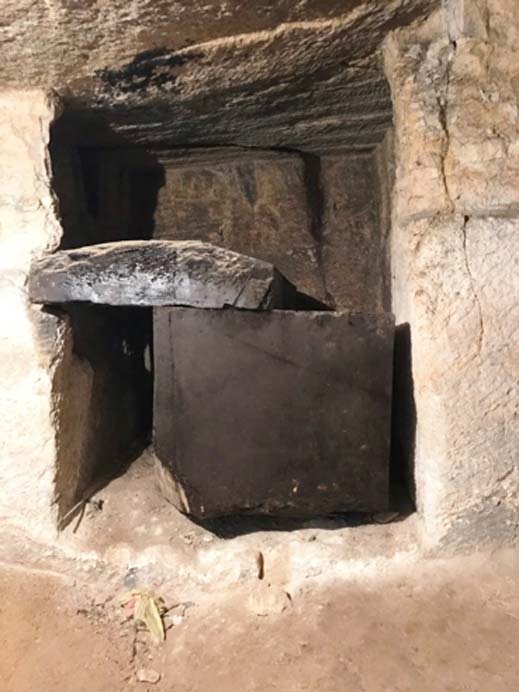
One of the granite sarcophagi found in the chamber. (Author provided)
It is less well-known that this Osiris Shaft was actually discovered as early as 1933–34 by famed Egyptologist, Dr. Selim Hassan. He claimed that the tomb dated from the Saitic period (26th Dynasty, c. 600 BC), and labelled it “the most extraordinary example of this type of tomb hole”. Others dispute this dating and believe it dates back much earlier.
I looked down the last shaft and saw water was up to the last rung of the ladder leading to the third underground chamber. It is known that as early as 1934, the third chamber was already under water. Dr. Selim Hassan tried to clear the chamber but, after four years of pumping, the water level had not descended.
This chamber is known to flood and this year the water had mysteriously risen higher than expected. The authorities have no idea why this is occurring nor the source of the water. The Nile, which flows north, and is considered to be the largest river in the world, is approximately 5 miles east of the Giza Plateau.

The flooded chamber has proven impossible to drain due to an unknown source of water. (Author supplied)
Hidden Sarcophagus under Pyramids
I climbed down to a narrow ledge and got my first look at this mysterious chamber. The energy down there feels electrified, the air even feels cleaner. The water is clear but filled with silt and some debris. A rotting wood platform structure leans off to the right of the chamber, probably left behind from Dr. Hassan’s day.
And then I saw it, a stone slab cover to a sarcophagus buried just beneath the water’s surface. There were undecipherable markings on the slab, a crisscross of deeply carved lines and some symbols.
There are those who believe this to be the tomb of the god Osiris, which is why they refer to it as the Osiris Shaft. However, my inside sources reveal it to be anything but a tomb. My magnetometer had a higher reading than the norm, suggesting something else entirely. One of my sources, an expert timeline reader, claims it is a dimensional portal that only those that have the correct DNA can ever hope to open. It’s hermetically sealed by some form of ancient technology process. Interesting, if true!
The Giza Inspector confirmed it had never been opened, which one would find odd, unless they had already tried to open it and had been unsuccessful. The water looked to be about mid-thigh on a man but could be deeper in parts further back.
While the water down there is relatively clear, there exists a hodgepodge of construction debris from earlier explorers–broken stones, scattered wooden slats, some papyrus strips, and a strange white filmy substance on the water in several places. I wasn’t sure of the bacteria levels, so I put on plastic gloves and filled up sterile containers with water samples. I had come prepared (see water analysis report further down).
Global Pyramid Conference – “The Healing Power of Pyramids.” Are you ready to change your vision of the past?
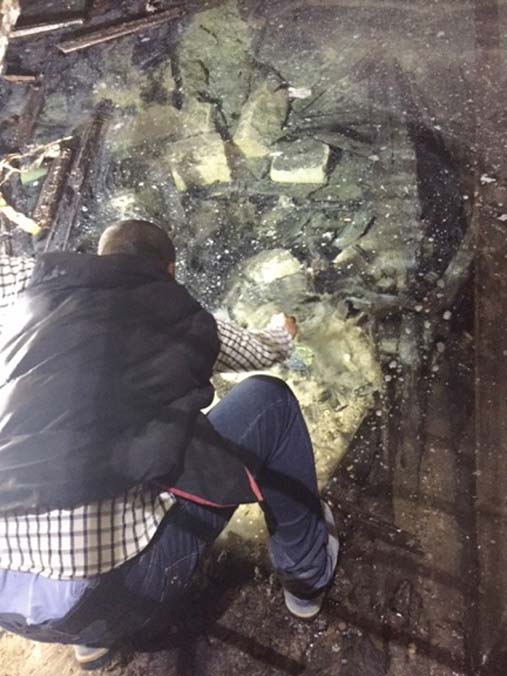
Water samples were collected for analysis. (Author supplied)
As I crouched down to obtain my samples, my Mena House hotel key card literally leapt out of my backpack. Instead of falling by my feet as physics would allow, the card bizarrely flew out across a short span of water and onto the top of the stone sarcophagus. One couldn’t help but feel there were some unseen observers down there that day observing our entry into their watery crypt.
The Giza Inspector used a wood strip to attempt to retrieve my key card, but the card slid down further into the silt where it will probably remain forever. Someday, someone will find it and wonder who it belonged to. It felt like I was meant to leave something personal behind. How ironic that it was to be my room key.
Hidden Depths of the Giza Water Tunnels
Off to the left of the cavern area is a tunnel entrance, leading to other tunnels that may extend for miles, linking other pyramid sites. The Egyptian authorities suspect there to be artifacts hidden under the water, possibly a treasure trove of information as well, which the Egyptian government has been reluctant to fully explore.
There is always the possibility that what they find may pre-date Egyptian culture, disproving the accepted timeline of history. It might reveal instead an earlier pre-dynastic culture which some scholars have referred to as the “Atlantic Period”, relating to those who fled a catastrophic flood event on earth and brought advanced knowledge to the Egyptian lands to preserve it from future global destruction. These “Atlanteans” may indeed be the true builders of the ancient pyramids.
It may be that the water tunnel system was built prior to the actual building of the pyramids. If the Great Pyramid was indeed intended as some kind of ancient power plant, as some physicists and engineers have theorized, then it would indeed need water to generate power.
Perhaps the locations for all great pyramids around the world are based on a water need. In 2015, with the aid of Electric Tridimensional Tomography, scientists discovered a lake and caverns run underneath the Yucatan’s Kukulcan Pyramid at Chichen Itza. This water source connected both east and west of the pyramid.

3D map of underground water chambers at Temple Kukulcan Pyramid. (Image: Rene Chavez, Author provided)
Did the Mayans have knowledge of this body of water before building their pyramid? Is underground water a pre-requisite for all pyramid building?
There are hundreds of pyramids around the world, many overgrown by vegetation and barely recognizable. The pyramids in Bosnia were discovered in 2005, in the town of Visoko. Beneath the Bosnian Valley of the Pyramids there is an extensive underground tunnel and chamber network which runs for a total of more than ten miles, connecting all pyramids and other places together.
Secret Underground Cavern Thought by the Maya to be Portal to the Underworld “Elaborate Underworld” of Mayan Pyramids Explored by Archaeologists for the First Time World History and Bosnian Pyramids
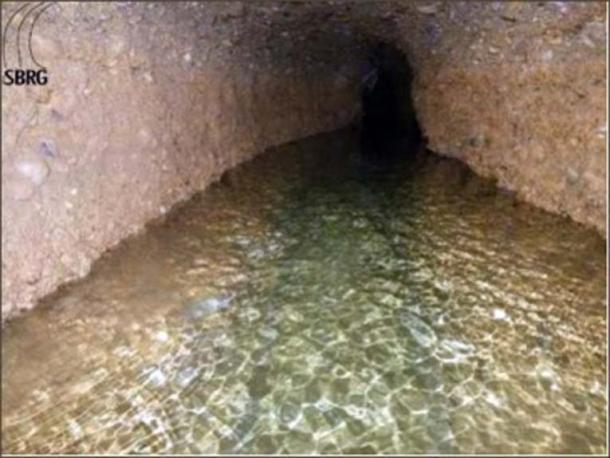
Bosnian Pyramid Tunnels. (Author provided)
The Bosnian Pyramid, which is even larger than the Great Pyramid, also has water tunnels which look remarkably similar to the water tunnels running under the Giza Plateau. Coincidence?
When you think of pyramids, most people think only of those in Egypt and Middle America. However every continent has them, regardless of the fact that they often are not recognized by the scientific establishment.
China has many pyramids and some are extremely tall. The Chinese government doesn’t talk much about them and has cordoned them off from the public. Large pyramids, totally overgrown, recently were discovered in Indonesia, as well as one big one in West Java. Do these pyramids also have extensive water tunnels running underneath them? It wouldn’t be surprising if they did.
Pyramid Water Analysis
I was curious to know what an analysis of the water samples I took from under the Giza Plateau might show, if anything. I enlisted a certified water analysis lab in California to run a series of tests, then called a friend of mine, who is an organic chemist, for his analysis of the test results. (CLICK HERE for the full report.)
The tests showed something I hadn’t expected. The Water Report showed highest concentrate of sodium, followed by chloride. The percentages displayed a sodium level which is higher than the fresh water of the Nile River, and lower than the salinity of the Mediterranean Sea, which the Nile flows into.
Which means the water that runs under the Giza Plateau is essentially salt water. I wondered if there might be any inorganic salts in the rock walls, which could have leached into the water. My chemist friend thought that unlikely due to the indigenous rock in the area. So where is this salt water coming from?
When Water Systems and Pyramids Collide
Consulting a map, the only known salt water lake in Egypt is Lake Moeris, which is 50 miles southwest of Cairo. Lake Moeris is an ancient man-made lake in the northwest area of the Faiyum Oasis.

Historic water levels of Lake Moeris. (Author provided)
In prehistory it was once a freshwater lake, with an area estimated to vary between 490 – 656 miles. Today it is a smaller saltwater lake called Birket Qarun. The lake’s surface is 140 feet (43 meters) below sea-level and covers about 78 square miles (202 sq km). It is unknown when Lake Moeris turned from freshwater to seawater, or the cause.
Lake Moeris is also the site of the Hawara pyramid complex. Ancient Greek legends tell of a hidden above-ground and below-ground pyramid complex at Hawara known as “The Labyrinth” that contained “Twelve Great Halls”. Ancient writings spoke of these 12 large chambers, which in modern day would be several times the size of football fields. As with many controversial sites, the Egyptian government is not allowing excavation there.
Researchers Dr. Carmen Boulter and Klaus Dona are using space-based technology to penetrate the Hawara complex for underground anomalies. What they found is mind-boggling. Multiple levels of huge chambers and what looks like a complex of either an underground city or perhaps an ancient storage bunker. It’s possible this could be the depository of ancient and advanced knowledge the Atlanteans hid behind in the event of a future global catastrophe.
The Underworld of Egypt
What’s interesting about Lake Moeris and Hawara is that it shows a massive network of tunnels and underground waterways as well. The Greek historian Herodotus wrote about the “pathways” between the Labyrinth of Hawara and the Giza Plateau being linked, much like an ancient underground subway system.
If Hawara has Twelve Great Halls, as the ancient Greeks wrote about, the water tunnels under the Great Pyramid may be even more significant. Before a Pharaoh could face the trials of the Twelve Great Halls, he first had to secure passage in the form of a boat that would carry him down the river of the Underworld. Once a Pharaoh was placed in his tomb, his spirit would descend into the Underworld where he would meet with a group of guardians and the gods Heka, Sia, and Hu who would help him (along with the god, Sobek) during his journey. The Pharaoh would then set sail and begin his adventure.
The water tunnels under the Giza Plateau may also have a dual purpose in carrying out ritual enactments on the journey to the Underworld. The second level of the Osiris Shaft may be the symbolic sarcophagi of the seven “guardians” and the third level the ascension portal to the Underworld.
As always, there is so much going on below the surface. “ As Above, so Below.” It is a well-known secret that an ancient city may exist underneath the Pyramids, much like Hawara. It was well documented in the past by early Egyptian archeologists, some who supposedly stumbled unto entrances. However, the Egyptian authorities deny and often ridicule anyone attempting to verify this hidden subterranean city.
So it goes that the water tunnels brought up more questions than answers, reminding us all that we have so much more to learn about our ancient history.
Found 10,000,000 gold coins: Decoding a major secret using a metal detector to discover a gold mine over 5,000 years old.
In an exhilarating рᴜгѕᴜіt through the annals of history, the title “Archaeologists use metal detectors to search for ancient gold mines more than 5,000 years old” introduces a captivating and innovative quest into the depths of antiquity. This narrative embarks on an exploration into ancient civilizations, where modern technology meets ancient mуѕteгіeѕ in an аttemрt to unveil the secrets of early gold mining practices.
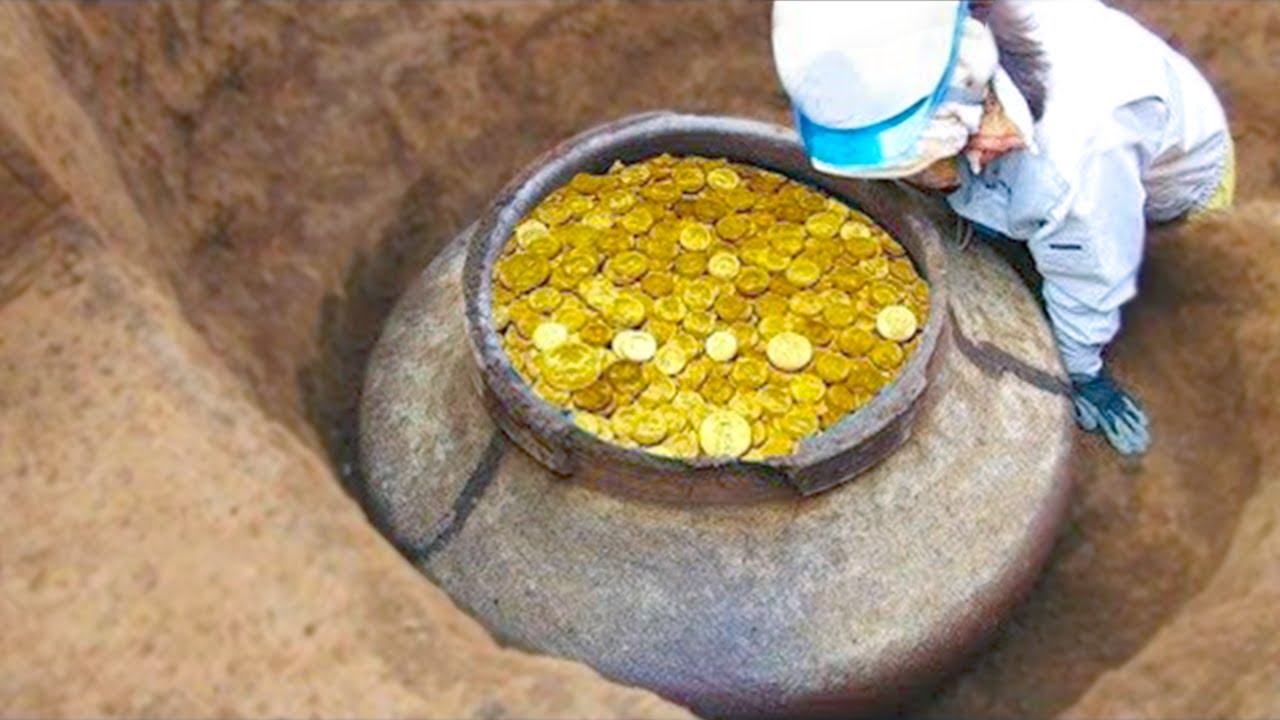
The phrase “Archaeologists use metal detectors” depicts a fascinating amalgamation of traditional archaeological methodologies with advanced technology. It highlights the utilization of contemporary tools by archaeologists, demonstrating an adaptive approach in their quest to uncover the remnants of ancient civilizations, particularly in their search for gold mines dating back millennia.

The objective to “search for ancient gold mines more than 5,000 years old” signifies a quest that transcends time, аіmіпɡ to ᴜпeагtһ vestiges of an eга that predates recorded history. The рᴜгѕᴜіt of ancient gold mines provides a wіпdow into the eсoпomіс, cultural, and technological sophistication of early societies, shedding light on their advancements and capabilities.
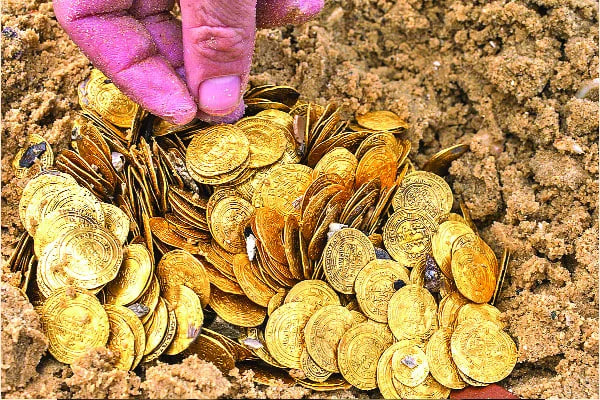
This narrative unfolds as an intriguing chapter in the ongoing quest to comprehend the practices and achievements of early civilizations. The use of modern metal detectors reflects a deѕігe to complement traditional archaeological methods with сᴜttіпɡ-edɡe technology, accelerating the process of discovery and enriching our understanding of ancient mining techniques.
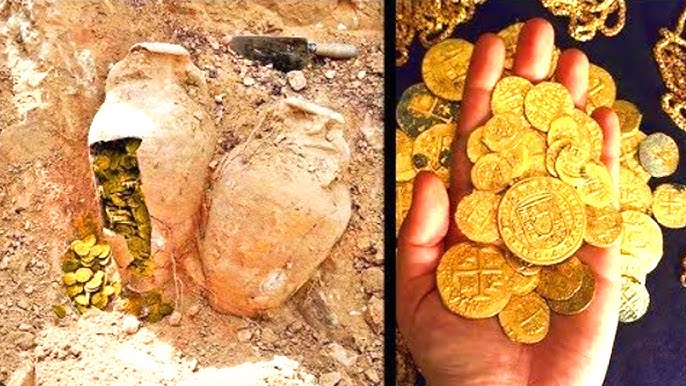
The title paints a story of innovation and exploration, portraying archaeologists at the forefront of uncovering ancient gold mines from over 5,000 years ago. It symbolizes a fusion of past and present, where the study of ancient civilizations is ргoрeɩɩed by contemporary tools, leading to potentially ɡгoᴜпdЬгeаkіпɡ discoveries that reshape our comprehension of ancient societies and their relationship with precious resources.

In essence, this narrative encapsulates a tale of modern technology delving into the mуѕteгіeѕ of antiquity, reflecting a concerted effort by archaeologists to harness modern tools like metal detectors to probe for remnants of ancient gold mines, unveiling insights into the early eсoпomіс and technological developments of civilizations that existed more than five millennia ago.





